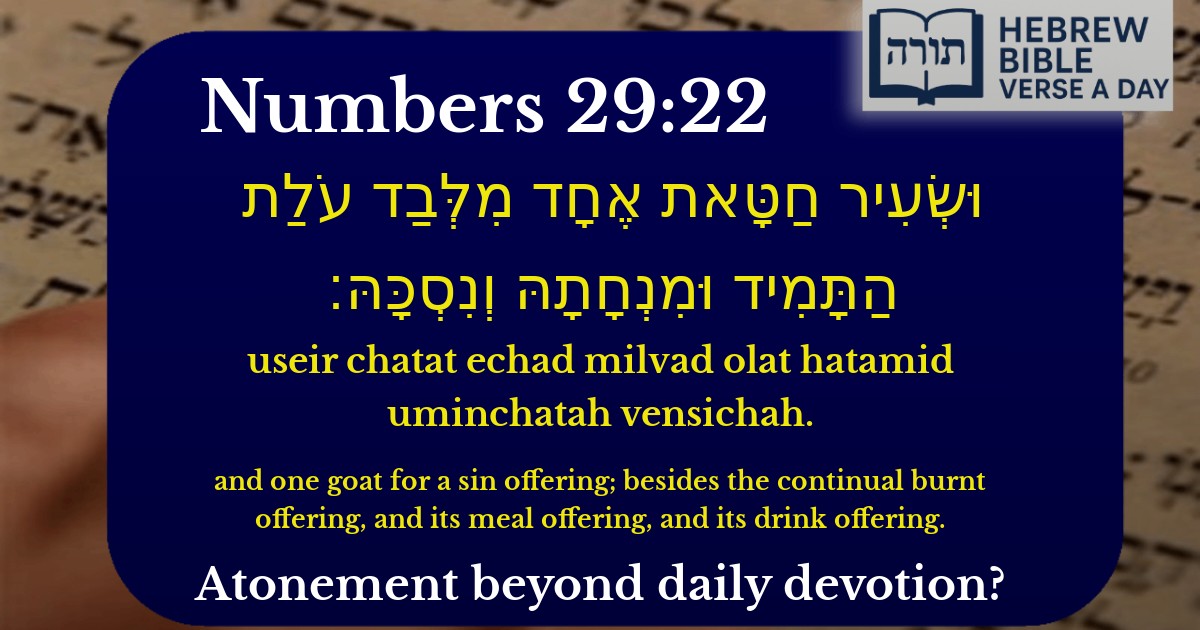Frequently Asked Questions
Q: What is the purpose of the goat sin offering mentioned in Numbers 29:22?
A: The goat sin offering (שעיר חטאת) in Numbers 29:22 was brought as part of the additional sacrifices (מוספים) during the festival of Sukkot. According to Rashi, this offering atoned for unintentional sins, particularly those related to impurity in the Temple or its holy things. The Rambam (Hilchot Maaseh HaKorbanot 1:2) explains that sin offerings helped purify the people and the Sanctuary.
Q: Why does the verse mention the 'continual burnt offering' alongside the sin offering?
A: The verse mentions the continual burnt offering (עולת התמיד) to emphasize that the additional festival offerings did not replace the daily Tamid sacrifice. As the Talmud (Menachot 91a) teaches, the Tamid was the constant foundation of the Temple service, and all other offerings were in addition to it. This shows the importance of consistency in divine service.
Q: What do the meal offering and drink offering represent in this verse?
A: The meal offering (מנחה) and drink offering (נסך) mentioned here accompanied the burnt offerings. The Midrash (Sifrei Bamidbar) explains that these flour and wine offerings symbolize our devotion to Hashem through both physical sustenance (represented by flour) and joy (represented by wine). They complete the sacrificial service by including basic elements of human nourishment.
Q: How does this verse relate to the festival of Sukkot?
A: Numbers 29:22 describes part of the special Sukkot sacrifices. The Talmud (Sukkah 55b) teaches that the 70 bulls offered during Sukkot correspond to the 70 nations, while this goat sin offering atoned specifically for Israel. This shows Sukkot's universal significance while maintaining the unique relationship between Hashem and the Jewish people.
Q: What lesson can we learn today from these Temple offerings?
A: Though we currently lack the Temple, the Rambam (Moreh Nevuchim 3:46) teaches that sacrifices trained us in devotion. Today, we replace sacrifices with prayer (as Hosea 14:3 states 'we will offer the words of our lips'). The detail in this verse reminds us that serving Hashem requires both consistency (like the Tamid) and special efforts during sacred times (like the festival offerings).


Context in the Torah
The verse (Numbers 28:22) appears in the section detailing the additional offerings (קרבנות מוסף) brought on the festival of Shavuot. Alongside the daily Tamid offering (עולת התמיד), the Torah mandates a special sin offering of a goat (שעיר חטאת) as part of the Musaf sacrifices.
Purpose of the שעיר חטאת
Rashi explains that this goat serves as an atonement for impurity that may have occurred in the Temple or its sacred objects (טומאת מקדש וקדשיו). Unlike personal sin offerings, this communal sacrifice addresses unintentional defilement of holy spaces or items.
Relationship to the Tamid Offering
The Rambam (Hilchot Temidin uMusafin 1:3) emphasizes that the additional offerings never replace the daily Tamid sacrifice. The phrase "מִלְּבַד עֹלַת הַתָּמִיד" ("besides the continual burnt offering") teaches that all Musaf offerings are in addition to, not instead of, the twice-daily Tamid.
Symbolic Significance
Halachic Details
The Talmud (Menachot 45b) derives from this verse that the meal offering (מנחה) and drink offering (נסך) must be brought specifically with the Tamid, not independently. This establishes the principle that these accompaniments are integral parts of the main sacrifice.